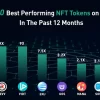Undoubtedly, the term “blockchain technology” arises frequently in discussions surrounding digital currencies like Bitcoin. As time progresses, blockchain is anticipated to expand and become more user-friendly.
To address the question, “What is blockchain technology?” it’s essential to explore its functionality, potential applications, advantages and drawbacks, and its growing significance within the digital realm. The following information delves into these aspects in greater detail:
How does it work?
Blockchain serves as an open or public digital ledger that maintains a record of transactions or data across a computer network. Alterations to the transactions and files recorded in the ledger are not possible.
Two key aspects of blockchains include their immutability and the absence of a central authority. The ledger’s resistance to change ensures that the information it contains is reliable. Furthermore, the decentralized nature of a blockchain network makes it difficult to attack.
How does blockchain function?
Blockchain operates as a system that documents transaction records within blocks. Each transaction within this digital ledger necessitates the digital signature of the proprietor. This signature authenticates the transaction and prevents tampering, thus safeguarding the data stored in the blockchain.
The functionality of blockchain involves a series of stages that may vary based on the consensus mechanisms employed. For instance, Bitcoin relies on Proof of Work (PoW) for transaction verification and addition to the blockchain. The process of mining Bitcoin can be distilled into the following steps:
Step 1: Initiating a transaction in the blockchain
When someone sends Bitcoin, they must pay a fee, often referred to as a “gas fee,” to facilitate the verification of the transaction by a computer network.
Step 2: Blockchain begins transaction verification
Upon completion of the transaction, the blockchain examines its accuracy. The transaction joins other pending requests in a queue to be included in a new block.
Step 3: Block creation
A block symbolizes the chosen transaction or data. The blockchain stores records and transactions in units called “blocks.” For instance, a typical block in the Bitcoin blockchain contains over 500 transactions.
Each block’s information is dependent on and connected to the preceding block’s data, resulting in a chronological chain of transactions. Hence the term “blockchain.”
Step 4: Miners receive the block
The block is distributed to every computer node on the network. In public blockchain networks like Bitcoin, these nodes are known as miners.
Step 5: Miners work to validate the transaction
Miners attempt to confirm the transaction by solving intricate cryptographic puzzles to generate a hash. The first to solve the complex cryptographic puzzle receives mining rewards.
A hash is a 64-digit hexadecimal number, constant in length regardless of the file size. Upon creating a hash, subsequent blocks in the blockchain employ the previous block’s hash to generate their own.
The hash is added to the block using cryptography, which requires inputting the key and information from the last block. Cryptography keys consist of two parts: the Private Key and the Public Key.
Cryptographic keys ensure successful transaction completion between two parties and trigger a network alert if someone attempts to alter data.
Step 6: Adding the block to the chain
Once authorized nodes approve the transaction, the block joins the blockchain. A majority of the network’s nodes must concur that the new block’s hash was accurately calculated.
Each block in the chain contains information from the previous block. Consequently, altering or deleting data in one block necessitates modifying all subsequent blocks. This deters hackers since any data changes would be immediately apparent to the entire network.
After updating all network nodes, the transaction concludes. This mining proces makes the blockchain more secure and harder to tamper with existing blocks.
How blockchain is used
Blockchain eliminates the need for an intermediary, such as a bank, to facilitate cross-border money transfers. This results in quicker and less expensive transactions.
The internet revolutionized communication by enabling email, and similarly, blockchain technology allowed cryptocurrencies like Bitcoin to thrive. However, blockchain has numerous applications beyond cryptocurrencies.
Blockchain ensures that data cannot be altered, hacked, or tampered with in any way, protecting both physical and digital assets. Intangible assets include patents, intellectual property, and copyrights, while tangible assets encompass homes, cash, cars, and land.
Cryptocurrencies, digital tokens, and NFTs all rely on blockchain technology, but its potential extends to various other fields. Some of them are:
Supply Chains
Blockchain-enabled trades facilitate product history tracing. The technology is now being utilized to identify the origins of precious metals and food.
Walmart and IBM collaborated to develop a food-tracking system using open-source ledger technology, making it easier to detect spoiled or contaminated products.
Banking
The financial sector is increasingly adopting blockchain technology, with companies investing in it to streamline payment tracking and record-keeping.
For instance, Barclays, Canadian Imperial Bank, and UBS are exploring how blockchain can enhance the efficiency of their back-office settlement processes.
Voting
Blockchain-stored information could lead to tamper-proof election results.
Healthcare
Blockchain can streamline healthcare processes by reducing health insurance claim processing times and securely storing, sharing, and transmitting medical data and records. Patients can maintain privacy and full control of their medical records.
Property Records
Blockchain-based land records could lower title search and insurance costs and quickly establish property ownership.
Encrypted property ownership records on the blockchain can be verified anytime, ensuring their accuracy and immutability.
Automated Ad Campaigns
Advertisers can leverage smart contracts and blockchain technology to automate ad campaigns. Ads can be displayed to specific groups only when certain conditions are met, optimizing target audience reach.
Tracking System
The unalterable nature of blockchain transactions simplifies tracking laundered money back to its source for governments.
NFT Markets
Non-fungible token (NFT) sales surged in 2021, increasing blockchain technology adoption. NFTs represent digital assets such as artwork, songs, videos, and more. They can be purchased, sold, and traded online, becoming a prevalent way to transact digital art.
Why using blockchain tech is great
Several key reasons make blockchain technology appealing to users. Some of the advantages of employing blockchain include:
Transparent and secure data
Blockchain’s primary benefit is its security. With millions of computers constantly verifying and exchanging information, data exploitation becomes nearly impossible.
Swift transactions
Without intermediaries like banks, blockchain transactions are more efficient.
Error resiliency
Every computer node possesses a copy of the ledger, ensuring that a single node’s failure doesn’t disrupt the network’s functionality.
Cost efficiency
By eliminating middlemen and third parties, blockchains reduce transaction-associated costs.
Peer-to-peer exchange
Cryptocurrencies such as Bitcoin and Ethereum enable users to send funds directly to anyone worldwide without a banking intermediary, which typically charges transaction and handling fees.
Open-source
Public blockchains use open-source software, granting access to transaction data and source code. Individuals can even utilize the code to develop apps and propose improvements.
Universal banking
access Over two billion people lack a bank account. Blockchain offers a storage solution for funds, potentially assisting the unbanked and protecting against theft associated with physically storing money.
Potential drawbacks of employing blockchain technology
Blockchain is renowned for its unchangeable nature, facilitating business between strangers without requiring trust. This characteristic has earned it the moniker “trustless” technology.
However, blockchain isn’t without risks and downsides. Concerns have been raised regarding public blockchain ownership and accountability when things go awry.
Altering information on a blockchain can be time-consuming and laborious. Additionally, storage space may increase significantly over time, posing a risk to the network if the blockchain becomes too large for users to download. Other issues include:
Irreversible transactions
Once conditions programmed into a blockchain protocol are met, transactions cannot be undone, altered, or halted. Nothing—neither banks, governments, nor third parties—can interfere.
Environmental concerns
Blockchain networks like Bitcoin require substantial electricity for transaction verification, negatively impacting the environment. Bitcoin’s electricity consumption surpasses that of small to medium-sized European countries.
Nonetheless, some argue that Bitcoin adheres to stricter environmental standards than other entities. A study revealed that Bitcoin mining consumes less energy than traditional banking systems.
Personal responsibility
One of the greatest aspects of blockchain technology and cryptocurrencies also presents challenges. Crypto wallets, where cryptocurrencies are stored, require individual management. Users are solely responsible for wallet passwords and decisions regarding their funds. However, losing seed phrases—a series of words granting wallet access—means losing wallets permanently.
Misconceptions
Cryptocurrencies have been associated with illicit activities, such as Silk Road, an online marketplace for money laundering and illegal drug purchases using Bitcoin. This misconception hinders broader acceptance of cryptocurrencies.
Conclusion
Blockchain technology continues to evolve, attracting more businesses to invest money, time, and resources. Consequently, additional use cases will emerge. Though this overview only touches upon blockchain’s potential across various industries, opportunities in this sector are anticipated to grow exponentially.











[…] Envision a blockchain as a database spread across numerous computers simultaneously. When a transaction entry, referred to as a “block,” becomes part of the chain, altering or modifying the information within becomes extremely difficult. Consequently, it’s near impossible to cheat or compromise the blockchain network, making it highly secure. Read our complete guide about crypto technology. […]